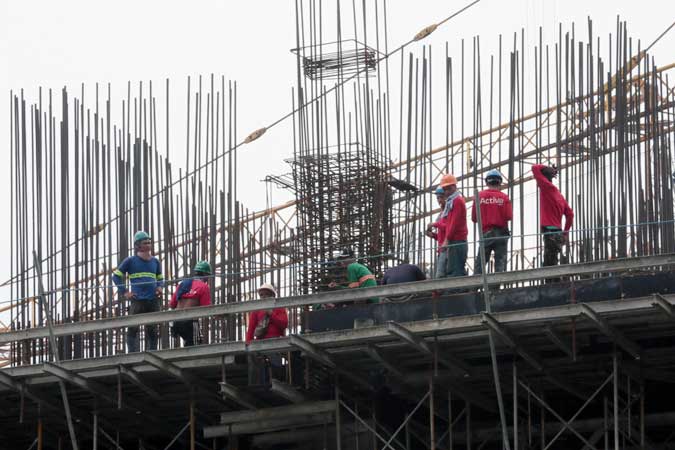By Nadine Mae A. Bo
THE PHILIPPINE ECONOMY in the first quarter declined at a slower pace than previously reported, the Philippine Statistics Authority (PSA) said a day before it announces preliminary figures for the second quarter.
Gross domestic product (GDP) — the value of all finished goods and services produced in the country at a given period — fell by 3.9% in the January-March period, slower than the 4.2% drop initially reported on May 11, the PSA said on Monday.
The services sector fell by 4.1% in the first quarter, slower than the initially reported decline of 4.4%.
The following subsectors in services saw higher growth or slower contractions in the revisions for the first quarter: professional and business services (-4.4% from -6.5%); real estate and ownership of dwellings (-11.7% from -13.2%); human health and social work activities (13.2% from 11.7%); education (0.2% from -1%); wholesale and retail trade (-3.4% from -3.9%); and information and communication (6.5% from 6.3%).
Meanwhile, sharper declines or slower growth were noted in the following subsectors: accommodation and food service activities (-22.5% from -20.6%); financial and insurance activities (4.3% from 5.2%); transportation and storage (-19.6% from -18.8%); and other services (-38.7% from -38%).
The industry sector’s performance was revised to a 4.4% contraction in the first quarter, from the initial 4.7% drop. Subsectors that saw upward revisions were mining and quarrying (1% from -1%) and construction (-22.6% from -24.2%).
Electricity, steam and water and waste management posted slower growth at 1.1% from 1.9% previously. On the other hand, manufacturing growth was roughly unchanged at 0.5%.
The decline in the agriculture, hunting, forestry, and fishing sector was revised to 1.3% from 1.2% initially.
Among the items on the expenditure side, capital formation saw the largest revision with a 14.8% decline in the first quarter compared with the initial 18.3% during the same period.
Household spending posted a revised 4.7% fall from the previously reported 4.8% drop, while government spending remained steady with a 16.1% growth.
Trade in goods and services figures were also tweaked, with exports (-8.8% from -9%) and imports (-7% from -8.3%) contracting less than initially reported.
“The revision to the first-quarter GDP is a welcome development and a reminder of how the economic recovery and virus mitigation go hand in hand,” said ING N.V. Bank Manila Branch Senior Economist Nicholas Antonio T. Mapa in an e-mail.
He added that the major contributors such as construction and select services likely benefited from the looser mobility restrictions at the time when the country was reporting relatively low new cases of COVID-19.
Meanwhile, Rizal Commercial Banking Corp. Chief Economist Michael L. Ricafort attributed the upward revision to faster infrastructure spending and the accommodative monetary policy by the Bangko Sentral ng Pilipinas (BSP), which kept key interest rates at the record-low 2%.
“The start of the vaccination versus COVID-19 in the country since March could have also helped boost confidence by both businesses and consumers, thereby supporting economic recovery prospects for more industries,” he said in a separate e-mail.
The first-quarter 2021 revision comes ahead of Tuesday’s release of the preliminary estimate for GDP performance in the second quarter.
A BusinessWorld poll of 20 analysts yielded a GDP growth estimate of 10.6% for the second quarter, a turnaround from the annual contractions of 3.9% and 17% posted in the first quarter of 2021 and the second quarter of 2020, respectively.
The government expects the economy to grow by 6-7% this year.
“We expect all sectors to contribute to growth save for the government expenditures on the expenditure accounts. [Based on industrial origin], both services and industry are set to post double-digit gains while agriculture [is expected to be] pulled back,” Mr. Mapa said on his outlook for the second quarter.
However, he noted that the double-digit growth across these sectors is driven largely by base effects and that quarter-on-quarter growth is likely to remain negative given the reimposition of a lockdown in April, coupled with elevated unemployment and soured sentiment by the second quarter onwards.
“As such, the Philippines exited recession [in the second quarter] but will likely experience a double-dip recession by the third quarter after quarter-on-quarter GDP falls negative for at least two quarters,” Mr. Mapa said.
Mr. Ricafort, for his part, said measures to further reopen the economy would have supported the rebound in the second quarter if it were not for the stricter restrictions imposed in late March to mid-April.
He cited increased government spending, the implementation of a law that cuts corporate income tax and reforms the tax incentive system, and low interest rates as economic drivers for the second quarter.
The Philippine economy may still expand in the third quarter due to base effects, Mr. Ricafort said, with the ongoing two-week enhanced community quarantine in Metro Manila and other areas weighing on growth.

